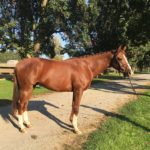[Sidebar series on my own horses. More Tevis blogging to come shortly.]
I should begin with a disclaimer – I don’t profess to present a compilation of the experiences and opinions of a group of learned individuals on the subject of imprinting. As any blog admits, this simply shares my personal experiences which have been largely positive. And I hope it is marginally entertaining to read.
The Crazy Idea
(As some of you will remember…) In May of 2012, I purchase a purebred Arabian mare named Tosca BL. Tosca was not unknown to me. She was bred by Peter Rich of Bay Laurel Arabians and – as a steady rider of Peter’s horses for quite a few years – it fell to me to start Tosca when she turned four. We went on to compete fairly successfully in competitive trail and endurance for about four years before I moved to riding other horses for other owners. But I would always try to get to Bay Laurel to visit Tosca (and other friends) a couple of times a year. She is the horse of my heart.
So when Peter let me know that he was looking to decrease his herd size, I immediately raised a hand to take my girl. The complicating factor was that she had bred herself (she’s a tart) the preceding fall and was due to deliver in late July. So I basically picked up a BOGO (marketing-ease for buy one get one) on horses. What was I thinking? And with zero understanding of what it meant to raise a foal.
Not long after, I went to Horse Expo in Sacramento with a couple of friends. On the agenda was a talk by Robert Miller, DVM on the subject of imprinting horses. I ended up reading his book cover to cover and lying awake nights thinking how I’d manage it, whether Tosca would let me do that to her baby, what it would be like, zzzzzzz.
How It Happened
My pretty little mare decided to buck the trends and deliver her first born (she was 13) smack in the middle of the day on a Saturday. I got a text as I was dismounting from BA Bearcat – the horse I was to ride a week later at Tevis which screamed COME NOW!?. I was in Napa. Tosca was in Novato. There was a race on at Infineon Raceway (mid-way in between). You can guess the rest.
But the foal was at least still on the ground when I did finally get there, he hadn’t stood up yet. A gorgeous, tiny, chestnut colt with four dark feet and a lovely blaze. His little ears were so ridiculously sculpted that when a picture was posted to Ariat’s Facebook page people asked if he was a Marwari.

I carefully sat on the ground (still dressed in my breeches and half chaps) behind him and began to rub his head, those ears, his legs, all over his body. Tosca stood by, curious but completely trusting. Claudio (keeping up the Italian naming tradition) was amenable and took me in as if I was an expected part of his new world. When he was ready to stand, my two amazing friends who had witnessed the birth – Cris Jones and Julie Buxton and I helped him get the hang of it. It took all of us and a decent amount of patience to get Tosca and Claudio clued in on the nursing thing a comedy of errors on both human and equine sides. The three of us spent the entire afternoon handling that tiny chestnut body and marveling at the miracle of life in the warm sun of a late July day.

On his second day of life, Claudio was descended upon by pretty much every friend I have within driving distance. And their kids. It was a circus. The vet came to check on him and suggested you might not want to have all these people around him. She was probably right, but Tosca my primary gauge – was fine with it. Most of them brought carrots or apples, mistakenly thinking Claudio came with teeth, so that mare made out like a bandit. And everyone was so wonder-struck by the chance to see and touch an infant horse that I couldn’t turn them away.
His first few months of life continued in that pattern. If I wasn’t messing with him, Julie’s husband Joe was scratching any body part Claudio presented. Or little kids back for a second or third visit – were petting him and running and yelling right by him.

He had a tiny little halter on his head in the first couple of weeks. This was not as easy as it sounds because even the smallest web halter they make for baby horses was huge on his little Arabian noggin. I had to get an eensy-bineensty rope halter custom made for him off of eBay. It was in the size range usually for miniature horses, kind of embarrassing.

A nice fat, soft rope lead that came as a gift was run all over him and under him and between his legs and through his ears.
We had leading down by a month and, although he wouldn’t go too far from mom I could get him to stop and back up from both sides. He learned to tie gradually using elastic objects (bungee cords and the like) until it became no big deal to tie him anywhere.
He and his mom hopped into and out of Julie’s trailer over and over with Cris’ help no problem!
I started ponying him bareback off Tosca in their paddock and by the time he was three months old we saddled up and were going down a moderately busy road, into a small open space park for short rides.

The Results

I know there are opponents of imprinting who maintain that it makes the horse too familiar, removing the respect they need to have for us much-smaller and more-delicate humans.
I can acknowledge that might be an issue, but as with all things in life the variables of the individuals must be factored in.
Claudio gets that I’m the boss of him. But, not unlike his mother, he’s willing to try those boundaries to see what he can get away with. I like that in a horse, an independent mind (play along, that’s how I see it). If I speak to him sharply it’s enough for him to learn the behavior isn’t allowed. That doesn’t mean that he won’t try again, but he does so with a look on his face that tells me that he knows he’s going to get in trouble.
At 20 months old, he is still interested in putting parts of me in his mouth if he can, but he has never actually bitten me (I’m almost afraid to type that). If I spend too much time cleaning his stall, he’ll decide maybe I’m there for play. But a poop fork is pretty dissuading. Those are the worst things he does.
On the flip side, he has the ground manners of a grown horse. He backs, he moves over and he walks at my shoulder from both sides. Until he sees something alarming (okay, still a 20-month-old Arabian here), but even then he is totally responsive to the halter and doesn’t pull or drag me and he’s only run into me a handful of times. I can pick and file his feet (he’s been handled by two farriers with no trouble), groom him with all types of tools and hose off his legs (patience, we’re working up to a full bath). I can even, wait for it, spray him with fly spray!
I put a bareback pad on him and a bit in his mouth. He lunges (we don’t do much, but he knows the principles and responds to voice commands) and I continue to pony him with his mother. It is definitely more exciting now that he’s nearing her in height, but the neighbors are entertained at least.
When he was six months old I had him out with Tosca in the park and we were approached by a group of adults with disabilities, out for a walk. Their escort asked if they could pet the baby horse. I looked down a little dubiously at his little red head and said sure, just come up slowly. Each of them maybe eight in all took a turn approaching him and quietly petting him all over his head and neck with evident wonder. He stood like a rock, as did his wonderful dam, and let each one have a turn. I was never so proud of my ponies.
Another important benefit. This is a young, male horse. As such, you won’t be surprised to find out that he has managed to injure himself pretty good a couple of times and was the host of a horrific bought of pigeon fever last fall. Doctoring his injuries (he split his pole open when he was about eight weeks old and he just recently opened up an eight inch gash down his right hind leg) is infinitely easier than it would be on an untouched horse of his age. It’s going to happen; young horses get hurt. Seems to me being able to tie and handle them in those inevitable moments would be worth the imprinting work alone.
Claudio and Tosca now live on an Arabian breeding facility in Pleasanton (so he could grow up with other young horses). Every baby that hits the ground there makes my hands itch to get in the stall and rub on them.
To be honest, even if at some future point I discover a significant drawback to having made my now-grey gelding too familiar, I would still balance it out positive for the wonderful experience of having spent all this time touching and interacting with him. But I’m confident that I have a really nice horse on my hands that might, just might, turn out to be an excellent endurance mount.







